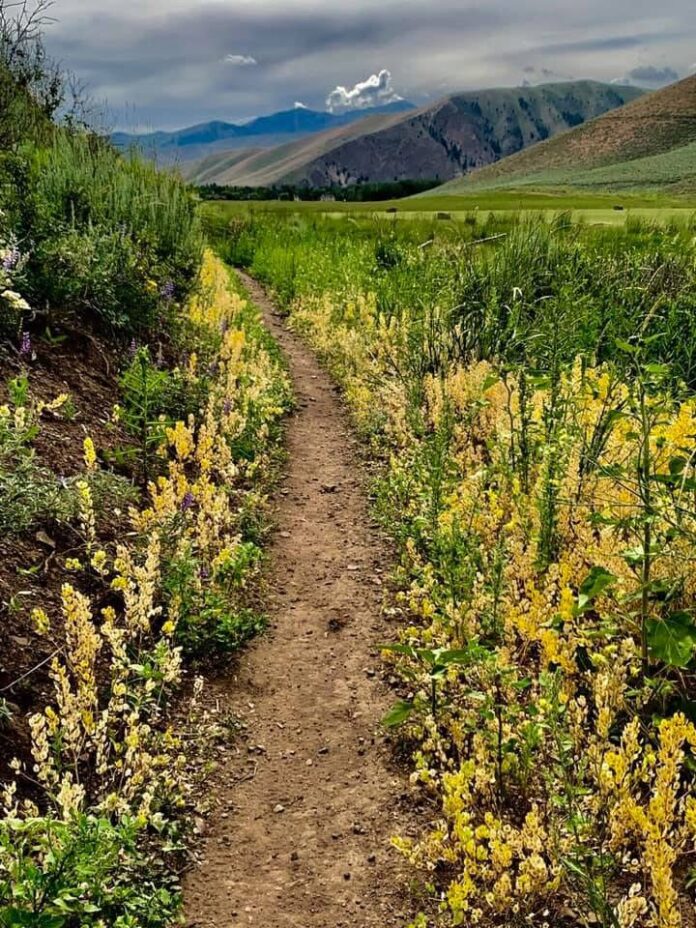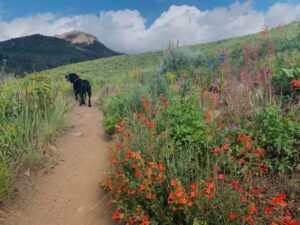
Maintenance Volunteers Step Up With Federal Staff Stretched Thin
BY Mark Dee

Earlier this month, Greg Travelstead headed south out of Hailey to get an early start on spring. But at public campsites and popular trailheads through Utah and Arizona, he saw a bleak vision of the summer ahead in central Idaho.
“Mountains of trash—mountains,” said Travelstead, president of the Pulaski Users Group, a central Idaho-based trail maintenance nonprofit. “It looks like a garbage strike in New York City already, and it’s only April.”
With federal land managers stretched by the job cuts, hiring freezes and incentivized resignations—plus reports of employees bracing for further layoffs—Travelstead’s PUG and other partner groups are preparing for an uncertain summer in the Sawtooth and Wood River valleys. That’s especially true on the trails, which require steady maintenance to keep pace with mounting recreational demand—work that often depends on federal coordination and funding.
“It’ll only take one season of not doing trail maintenance for people to feel the hurt,” he said.
The Sawtooth National Recreation Area, which at last count saw some 600,000 of the 1.8 million people that visit the Sawtooth National Forest annually, has “zero” summer staff dedicated to recreation for the upcoming year, Travelstead told the Wood River Weekly. (By press time, neither the U.S. Forest Service nor the BLM responded to requests for comment on summer trail and maintenance plans.)
“They’re dropping like flies,” said Travelstead. Many have been reassigned, or took early retirement, or are on some sort of administrative leave. It’s a changing of the guard—and it’s chaotic. Morale is low, and they’re going to ground.
“We’re an extended family. You’re doing the same thing—whether you’re with the agency or outside, we’re stewarding public lands. And we’re grieving.”
Idaho’s public lands host more than 10,000 miles of defined trails, according to state figures. About two-thirds are maintained by “partner agencies,” volunteer groups, contractors and outfitters that work with federal land managers to clear priority trails on public lands. Many, like the statewide Idaho Trails Association, rely on federal grants to reimburse their costs.
Last year, the ITA worked on 332 miles across 75 projects, Melanie Vining, executive director, told the Wood River Weekly. This year, they hope to cover 400 miles over 90 projects, she said—just 4% of the state’s trail system. The ITA and Forest Service formalized those plans last fall, and Vining said they’re already funded for 2025. Going forward, though, she’s in “wait and see mode” about future efforts.
“It’s kind of like being on a treadmill, in some ways,” she said. “You think you’re making headway, but there are just still so many trails out there that haven’t seen maintenance in 10 or 15 or 20 years. It takes a lot more work to get those back. This hit to the Forest Service is going to be a huge detriment toward making forward progress every year. It will just require a lot more from partners if this is the new normal, or at least the normal now.”
Trail users may not immediately notice changes on remote backcountry trails, which year to year are less likely to be cleared anyway, Vining said. She expects popular trailheads closer to town—with their parking lots, trash cans and vault toilets that Forest Service staff typically prioritize—to feel the pinch more acutely.
“That’s what’s going to be catastrophic,” Travelstead said. “I don’t think they have anyone to clean the toilets.”
With that in mind, Travelstead urges anyone interested to get in contact with local organizations for quick-hit front country days. (PUG’s trips, often five- or six-day packs, aren’t casual affairs.) Locally, the Blaine County Recreation District and Wood River Trails Coalition aim to maintain the roughly 400 miles of trails around the valley, with the latter hosting volunteer events weekly throughout the summer.
“We don’t know what the next few years are going to hold, but we do know that public lands and trails aren’t going to maintain themselves,” Vining said. So, she hopes, Idahoans will make an extra effort to leave no trace, or clean up campsites, or volunteer in whatever capacity they can. And, she urges recreationists to call their elected officials and let them know the value of Idaho’s trails.
“It’s what we can do right now that helps. It helps me not feel so powerless,” she said. “A lot of decisions are out of our hands. There are things we can’t do anything about. But we can still definitely get out on the ground and find ways to support Idaho’s public lands.”
BCRD Emphasizes
Early-Season Trail Etiquette
With snow melting and trails drying fast, the BCRD’s network is already seeing “a lot of foot and bike traffic,” Ashley Knox, Blaine County Recreation District trails coordinator, said.
“Trail users need to be flexible with their plans when they head out on trails in the spring since some sections of trails take longer to dry out than others,” she said. “Trails that pass through north-facing slopes and that are at higher elevation will hold snow and stay wet for longer. This time of year, it’s common to start out on a dry trail and run into snow or mud along the way.”
If you do hit wet or snowy sections, turn around and find a better option. Only use trails that are dry or totally frozen, Knox said; if you’re leaving footprints or ruts in the trail, it’s not ready. Don’t ride around snow or mud.
“If turning around is not an option, walking through the mud is much better than walking or riding off trail,” Knox said.
Here are a few more points of etiquette to remember this spring, according to Knox:
–Bikes yield to hikers and horses, hikers yield to horses. Then, downhill yields to uphill traffic. When yielding to another trail user, bikers should put one foot down on the edge of the trail providing space for hikers or uphill traffic to pass. Please do not ride off the trail to go around people.
–Dogs must be under voice control or on a leash. Never let your dog chase wildlife.
–And remember, Knox says, “Be kind on the trails.”


